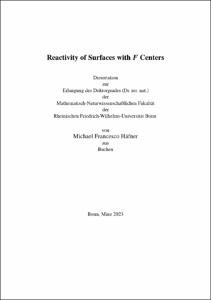Reactivity of Surfaces with F Centers

Reactivity of Surfaces with F Centers

| dc.contributor.advisor | Bredow, Thomas | |
| dc.contributor.author | Häfner, Michael Francesco | |
| dc.date.accessioned | 2023-08-24T10:33:39Z | |
| dc.date.available | 2023-08-24T10:33:39Z | |
| dc.date.issued | 24.08.2023 | |
| dc.identifier.uri | https://hdl.handle.net/20.500.11811/11006 | |
| dc.description.abstract | This thesis is concerned with the theoretical investigation of the chemical and catalytic properties of the alkali halide F center. It explores how density functional theory (DFT) and statistical mechanics can be applied to describe the defective system and its reactivity. The electronic properties of the alkali halides NaCl, KCl, NaBr, and KBr are investigated with a multi-level DFT approach consisting of the generalized-gradient approximation functional PBE and the self-consistent dielectric-dependent global hybrid functional sc-PBE0. The dielectric constants, electronic band gaps, ionization energies, and electron affinities obtained with this method agree well with experimental results. The electronic properties of the alkali halide F and M centers are calculated and are in agreement with previous theoretical and experimental research. The migration of the F center across the bulk and (100) surface is calculated with thermodynamic and thermal corrections, reproducing the experimental barriers for NaCl, KCl, and KBr. The barriers for the migration across the (100) surface are lower than for the bulk migration due to symmetry reduction. The electronic structure and geometry of the transition states are in agreement with experimental results The interaction of nitrogen with the F center is investigated. The defect reduces N2 and catalyzes its reaction with H2, halving the highest reaction barriers of the reaction compared to the gas phase reaction. The reduction is identified as main driver behind the catalytic effect, and the surface provides additional stabilization to the transition state and intermediate structures. The same results are obtained for the hydrogenation of CO and CO2, as the defect reduces all carbon-containing adsorbates and significantly lowers all reaction barriers compared to the gas phase. The calculated reaction rate for the synthesis of methanol is comparable to the conventional catalyst, but the intermediates formic acid, water, and methanol dissociate on the defect and deactivate the F center. Finally, the KCl M center is doped with a copper atom, which strongly interacts with the defect and alters its electronic structure. The doped defect still stabilizes CO, H2CO, and CH3OH, but it does not dissociate methanol to methane. Bi-hydrogenated copper, HCuH, is identified as a stable, reactive byproduct of the hydrogenation of CO on the doped defect, and the hydrogenation is catalyzed by the hydrogen affinity of copper. A kinetic Monte Carlo simulation of the methanol synthesis yields a reaction rate that significantly exceeds the rate on the conventional catalyst. In conclusion, the findings of this thesis provide a basis for future research into the chemical and catalytic properties of defective alkali halides. | en |
| dc.language.iso | eng | |
| dc.rights | In Copyright | |
| dc.rights.uri | http://rightsstatements.org/vocab/InC/1.0/ | |
| dc.subject.ddc | 540 Chemie | |
| dc.title | Reactivity of Surfaces with F Centers | |
| dc.type | Dissertation oder Habilitation | |
| dc.publisher.name | Universitäts- und Landesbibliothek Bonn | |
| dc.publisher.location | Bonn | |
| dc.rights.accessRights | openAccess | |
| dc.identifier.urn | https://nbn-resolving.org/urn:nbn:de:hbz:5-71359 | |
| dc.relation.doi | https://doi.org/10.1103/PhysRevB.102.184108 | |
| dc.relation.doi | https://doi.org/10.1021/acs.jpcc.1c00602 | |
| dc.relation.doi | https://doi.org/10.1021/acs.jpcc.1c07467 | |
| dc.relation.doi | https://doi.org/10.1021/acs.jpcc.2c02067 | |
| dc.relation.doi | https://doi.org/10.1021/acs.jpcc.2c08809 | |
| ulbbn.pubtype | Erstveröffentlichung | |
| ulbbnediss.affiliation.name | Rheinische Friedrich-Wilhelms-Universität Bonn | |
| ulbbnediss.affiliation.location | Bonn | |
| ulbbnediss.thesis.level | Dissertation | |
| ulbbnediss.dissID | 7135 | |
| ulbbnediss.date.accepted | 16.06.2023 | |
| ulbbnediss.institute | Mathematisch-Naturwissenschaftliche Fakultät : Fachgruppe Chemie / Institut für Physikalische und Theoretische Chemie | |
| ulbbnediss.fakultaet | Mathematisch-Naturwissenschaftliche Fakultät | |
| dc.contributor.coReferee | Kirchner, Barbara | |
| ulbbnediss.contributor.orcid | https://orcid.org/0000-0002-2765-6689 |
Files in this item
This item appears in the following Collection(s)
-
E-Dissertationen (4378)




